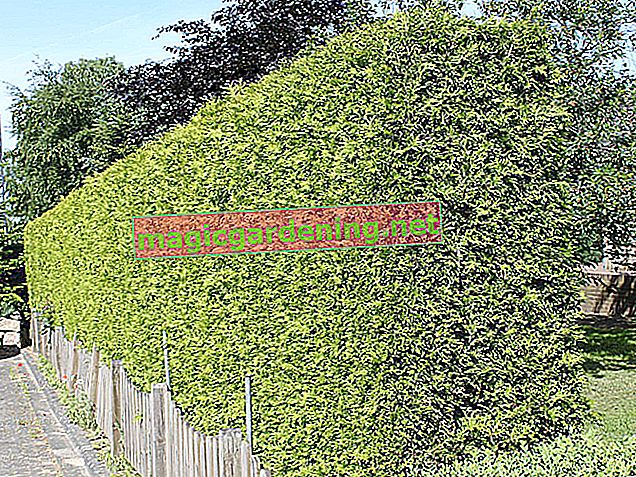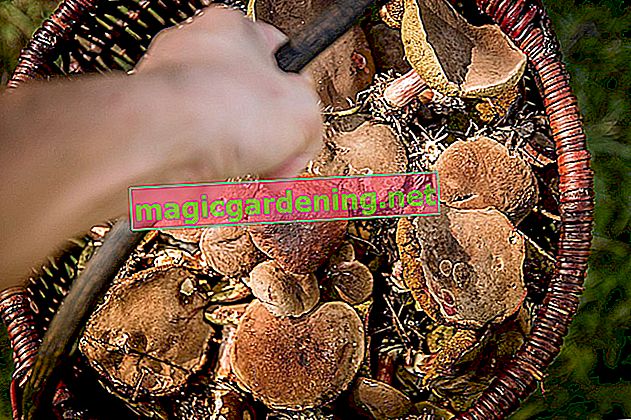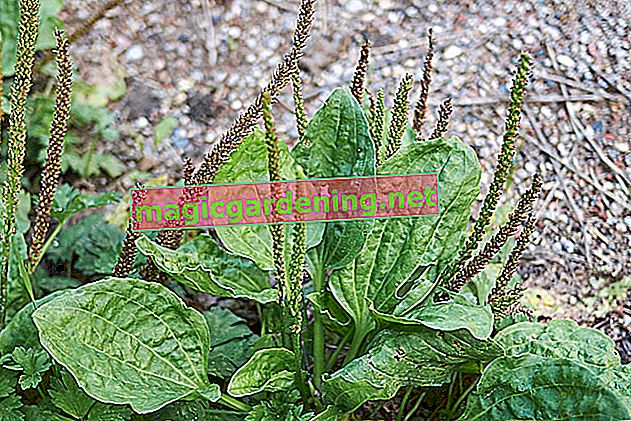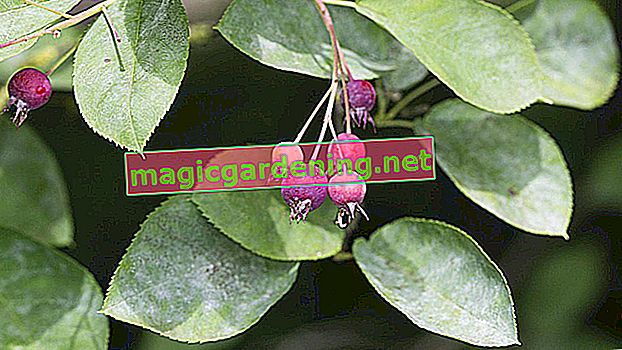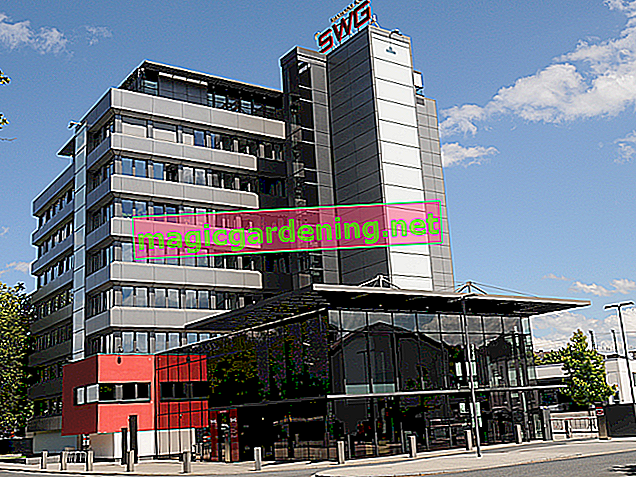
Is the Gardena irrigation system worth it?
The irrigation system (€ 69.29 at Amazon *) from Gardena emerged as the test winner of the Stiftung Warentest in 2018. Four systems were tested with which the garden can be watered automatically. The battery-operated devices can operate two circuits that run independently of each other. The manufacturer, who provides a free planner online for watering their own garden, offers customers a complete system for watering the garden. He can operate this both manually and automatically.
also read
- Watering plants properly - the best tips
- Sprinkling lawns with the Gardena irrigation system
- Watering flowers according to the lunar calendar - is there really anything to it?
Hoses
The system is based on garden hoses, which because of their material are ideally suited for continuous outdoor use. The hoses are UV-resistant and are made of environmentally friendly material that is free from heavy metals and toxic plasticizers. The manufacturer promises that the hoses can withstand even high water pressure and retain their shape.
The Power Grip profile is intended to ensure that the hoses can be combined with the brand's system components. For greater comfort and improved space savings, the brand has developed a spiral hose that is also suitable for small gardens, balconies and patios. The hose contracts automatically after use and does not have to be wound up by hand.
Fasteners
The hose connector systems are easy to use and can be attached to the hoses in a few simple steps. They ensure that no water escapes from the connection points.
Product overview:
- Tap connector : for indoor and outdoor taps, with or without thread
- Hose connector : for splitting, expanding or repairing hoses
- Water stop : automatic water stop
Sprinklers and showers

The product range is completed by a diverse range of spray nozzles with a sharp water jet and showers for gentle irrigation. Here, too, the manufacturer has thought of a high level of comfort. All products are equipped with an ergonomic handle and should also withstand frosty temperatures undamaged.
Gardena offers a range of sprinklers for evenly moistening large areas. However, the Stiftung Warentest criticized the unnecessarily high water loss. The system must be completely filled with water before it can build up enough pressure. The hoses drain completely after use.
Advantages and disadvantages
Gardena is one of the market leaders in the field of irrigation systems. The manufacturer enables easily accessible information for customers. All instructions are available on the Internet. However, the brand is often more expensive than the competition and the connector system makes the customer dependent on this manufacturer. If spare parts are required, the garden owner has to resort to Gardena products again.
Alternatives to the market leader
If you only have a small garden or need a simple solution for watering while on vacation, you will find a number of suppliers and manufacturers on the market. There are inexpensive offers at Obi, Hornbach or Bauhaus. If you do not have to carry out extensive planning and the focus is not on a professional irrigation system, you can get a good overview of the product range on Amazon.
| target group | Systems | Specialty | |
|---|---|---|---|
| Hunter | Firms and homeowners | Lawn and root watering of trees | Planning manual available online |
| Lechuza | Hobby gardener | Pot watering | various inserts for pots |
| Emsa | Hobby gardener | Pot watering | Irrigation of indoor and outdoor planters |
| Royal curtain | Private and commercial gardeners | Greenhouse, balcony and terrace, lawn | wide range |
| Blumat | Hobby gardener | Drip irrigation and irrigation control | Clay cone acts as a currentless sensor |
| Rainbird | Home gardeners and traders | Lawn irrigation, micro systems | large spare parts warehouse |
| WaterDrops | Hobby gardener | Complete set for bed irrigation | solar powered |
Where can an irrigation system be used?

There are many possible uses for an irrigation system. There are complete solutions for watering large lawns in the garden or micro-versions with which you can automatically supply your plants with water on the balcony and terrace or in the greenhouse. This way, you can go on vacation without any worries, without your plants drying up.
Irrigation systems are so versatile:
- Grab : automatic irrigation system without water connection with tank
- Garden shed : underground or above ground via a drip hose
- Indoor : currentless drip systems made of clay or current-operated systems with pumps
- Outdoor : watering trees, bamboo or hedges using hose systems
- Smart flower pot : double-walled vessel with battery-operated irrigation system, sensor data can be read via app
Automatic irrigation systems for large areas
Basically, automated systems work with a pressure reducer that is connected to a tap. Many systems include a filter so that they are not clogged by dirt particles from the rainwater. The device can be designed and expanded as required. The main hose can be connected to distribution pipes using connecting elements. These then spray the plants.
With the help of irrigation computers, the water flow can also be automated. These work with solar energy or are battery operated. This controls when and how long the water should flow. A sensor measures the degree of moisture in the soil. The measured values are decisive for the casting time. The plants are only watered when they really need water.
Good to know:
- adjustable amount of water
- underground installation possible
- Mixing devices for additional fertilization can be integrated
- Recommended for large lawns and gardens

Which pump is suitable?
All pumps work with a negative pressure, whereby the water is sucked in. There are various methods of creating this negative pressure. Pumps are classified according to how they work or where they are located. Therefore there are numerous names for the same models.
Digression
Old water supply with handle or piston pumps
These models are leftovers from the past and are now used as decorations in many gardens. They have a piston and a valve. As soon as the piston pulls upwards, a vacuum is created and the valve opens. The water can flow through until the piston drops again and the valve is closed by increasing the pressure. These pumps are operated manually by a lever. Since the system fills with air, it must first flow out by pumping movements. When the pipes are vented, the water is sucked in.Centrifugal pump
In these models, small impellers ensure that pressure is built up. When these rotate, a negative pressure is created and the water is sucked in. The performance of such pumps depends on the number of impellers. This can also influence the maximum delivery head. Centrifugal pumps have to hang in the water in order to work. If there is too much air in the lines, the pump will only start with great effort. Therefore, the pumps must be vented before use.
Jet pump
This variant is based on the centrifugal pump, but bypasses the disadvantage of venting. The pump itself ensures adequate ventilation. Such models are also called self-priming. Jet pumps are also known as jet pumps. Since they are being used more and more frequently to water lawns, beds and borders, the term garden pumps has established itself for numerous motor-operated or electricity-dependent jet pumps. These suck the water from a storage container.
Plan the irrigation system yourself
If you want to integrate an automatic irrigation system into your garden, you can plan it online. Many manufacturers offer a free planning tool, which makes the preparations easier for you. This first step is of great importance for the system to function properly later on.
Available amount of water
It happens again and again that too many sprinklers are integrated into the irrigation circuit. The water pressure is often insufficient so that the system is underutilized. With special measuring devices you can calculate the dynamic water pressure that exists in the pipes. You can then determine the number of sprinklers.
Create a sketch
For better planning, you should draw your garden to scale. You can determine the exact position of the sprinklers on the plan. It doesn't matter every inch. With this method, however, you prevent a 20 centimeter wide strip of lawn from drying out later.
Sprinklers must overlap
Basically, the further you move away from the nozzle, the lower the precipitation on one square meter. At the outer edge of the irrigation area, there is less water on the ground than in the immediate vicinity. To compensate for this, you should set up the sprinklers in a triangular or square pattern. Through the mutual spraying of the water, an even irrigation is achieved.

Small scale irrigation
Micro-irrigation is the efficient watering of flower pots and polyrattan planters, hedges and beds. With this method, only a small area of the soil is watered. Usually watering is done directly on the plant by drip or spray irrigation.
Advantages of micro irrigation:
- Water saving
- targeted and optimized pouring
- ideal for watering while on vacation
Herb pot
Herbs can be evenly hydrated with a simple irrigation system. The Emsa Aqua Plus irrigation system makes use of the wick principle. Water is automatically sucked from a reservoir via a special fleece and fed into the plant substrate in the flower pot.
The Fresh Herbs Trio herb pot works on this principle. A special planter serves as a water reserve, which can be filled through a special opening. A small flower moves with the water level out of the opening as soon as the reservoir is completely filled. The pot has space for three standard plastic pots.
House plants and flowers
Lechuza has developed an irrigation system for potted plants, which is used for watering indoor plants and for outdoor plant pots. If you want to place the rattan planter on the terrace and balcony, you can unscrew a floor screw. This opening has an overflow so that excess rainwater can run off downwards and a water supply is still maintained at all times.
Glasshouse
There are various options for automatically supplying planters or vegetables such as tomatoes and peppers in the greenhouse with water. The Tropf-Blumat system works without electronics. It regulates itself and opens the drippers as soon as the substrate becomes too dry. The system can be expanded and branched as required using additional elements. It can be operated via an elevated tank or connected directly to the tap with a suitable pressure reducer. This type of watering is also suitable for potted plants on the balcony.

hedge
For around 70 euros, the manufacturer Regenmeister offers a complete solution for watering hedges. A water line is laid above ground along the trunks and provided with a metering piece about every two meters. Nozzles are attached to these parts, which can irrigate the hedge along the water line at a distance of 1.8 meters on each side. If a spray point is no longer needed or should be left out, it can be closed with small stoppers.
Raised bed
Beds can be watered with spray or drip systems. With spray irrigation, the plants are supplied with water from above via a rod. A garden hose is connected to the rod. The water pressure can be regulated by hand via valves. The drip irrigation works via clay cones that serve as sensors. If the substrate dries out, the soil's suction power increases. This opens the passage of the clay cone so that the water can flow through.
Drip irrigation supplies plants with water exactly when they need it. This counteracts the waste of water.
Balcony box and hanging traffic light
Special irrigation solutions are also available for flower boxes (€ 13.18 at Amazon *) and traffic lights. There are numerous models, such as the Geli Aqua-Flor Plus flower box, which are equipped with an intermediate shelf. Underneath is the water storage tank, which is filled via a filler neck. The intermediate floor contains several suction cones that are filled with soil when the pots are planted. As soon as the substrate dries out, the water is sucked in from the reservoir. A water level indicator tells you when you need to refill your window boxes (€ 106.25 on Amazon *) with water.
How can I winterize my irrigation system?
Even if you have completely emptied the system, there may still be residual water in the pipes. If this freezes, material damage can usually not be ruled out. In order to better protect the systems from the effects of frost, the pipes are made of flexible polyethylene. This material can also break if water freezes in small spaces.
Store hoses
Let the pipes and pumps run empty and clean the devices thoroughly from deposits. Stow sensitive devices in safe boxes and stow them in a frost-free room. Hose trolleys and reels as well as wall hose boxes should also be dismantled and stored frost-free.
Blow out automatic irrigation systems
When you have a system firmly laid in the ground, all residual water should be removed. Remove the valves at the lowest point so that the water can run out. You can use a compressor to press air into the open pipes so that residual water is also removed from the pipes. In this way, nozzles, distribution hoses and sprinklers are blown free.
Seal open pipes
To prevent moisture, small animals, insects or worms from getting into the open hoses, you should seal the openings with plastic bags and rubber bands.
Build your own irrigation system
With just a few materials and a manageable investment of time, you can build a DIY irrigation system. By building it yourself and using recycled materials, you not only save costs but also protect the environment.
YoutubeAutomatic watering from the rain barrel
Use a rain barrel with a volume between 1,000 and 1,500 liters, which has a connection for a garden hose. Plug the hose into the connection and close the hose opening with a stopper.
Poke small holes in the material where you want the water to drip out. Route the hose to the base of the plants. If the pressure is too low, you will need to raise the water tank to a higher level. A small platform at a height between 50 and 100 centimeters is ideal.
Tips
Prefer irrigation systems that you have built yourself, as this makes you independent of manufacturers. Most brands' products are not compatible with each other.
Build your own irrigation system from a bottle
You need a clay cone, which are offered by Blumat or Aquasolo, for example, and cost between 15 and 20 euros in packs of four, as well as a PET bottle. The porous irrigation cone is screwed onto the water-filled bottle and inserted upside down into the substrate.
You can poke a few holes in the bottom of the bottle so that there is no negative pressure. As soon as the substrate dries out, water is sucked out of the reservoir. A two-liter bottle provides a 40-centimeter pot with water for ten days.

Self-watering growing container
You need a PET bottle and a used kitchen towel for the do-it-yourself variant. Cut the cloth into wide strips. Cut the bottle in two in the middle. Drill an eight to ten millimeter hole in the lid and thread a strip of kitchen towel through it.
Secure the strip with a knot and make sure that the cloth over the knot is about two inches long. Fill the belly of the bottle a few inches with water. Turn the lid on the bottle and insert the top part upside down into the bottle belly. Now fill the bottle with seed compost and sow herbs.
Tips
You can modify the structure further and put another bottle base over the cultivation vessel. An optimal microclimate for cultivation can develop under this hood.
Build sprinklers from PET bottles
If you want to automatically water small areas in the garden, you can build a sprinkler yourself with a disused PET bottle and a garden hose.
You also need:
- Hose connection
- Sealing ring
- Screw ring of a quick coupling
Use a sewing needle or nail to pierce four rows of thin holes in one half of the PET bottle. Connect the garden hose to the hose connection and put the bottle opening onto the connection. The joint becomes watertight with the sealing ring. To be on the safe side, you can fix the elements with tape. As soon as the bottle has filled with water, it sprays a water mist through the fine holes.
frequently asked Questions
How does the irrigation system work in Egypt?
For thousands of years, the Egyptians have used the natural fluctuations in the water level of the Nile to irrigate their fields. The Aswan Dam was built between 1899 and 1902 and was raised several times in the following years. It was considered to be the first dam that could hold a significant volume of water. It served to regulate the flood so that a constant flow of water could be guaranteed downstream.
In 1937 the Jebel-Aulia-Dam was built on the White Nile. This held back water during floods in the Blue Nile. With the amount of water that was dammed up by the two dams, the Egyptians were able to compensate for individual periods of low water in a year. Sometimes there are extreme ebb tides in the country, which can extend over several years. These periods could not be bridged with the amount of water. This led to the construction of the Aswan High Dam. At the same time, the sewer systems were expanded.
Functions of the Aswan High Dam:
- Production of large amounts of electricity
- Meeting agricultural water needs
- Daily water regulation for shipping
What types of irrigation systems are there?
There are different types of irrigation systems that can be used for different purposes. If you want to supply a large lawn with water, the pressure on the hose plays a major role. This decides on the amount of water that arrives on the surface. In raised beds and greenhouses, irrigation from above can make sense. Vegetables, on the other hand, should be watered at the base so that the leaves do not get damp. Young plants need constant soil moisture.
Overview of irrigation systems:
- Pop-up sprinklers: sprinklers for watering lawns
- Overhead irrigation : irrigation using a boom
- Drip irrigation : targeted watering at the base
- Spray irrigation : fine water mist
How high does the water pressure have to be to use an irrigation system in the garden?
A pressure of 0.5 bar is sufficient for the Regenmeister irrigation systems. The amount of water available is crucial for the system to function properly. You can determine this yourself using a simple method:
- Turn the tap on fully and fill a 10 liter bucket
- meanwhile stop the time in seconds
- Divide the value 36,000 by the result
If you have filled the bucket completely in 15 seconds, you have to divide the value 36,000 by 15 and get the result 2,400. 2,400 liters of water are available per hour. You can then use this value to determine how many nozzles you can install. The manufacturers have special tables for this.
How can I increase the pressure?
It is possible to increase the pressure by means of pumps. You must take the maximum permissible internal pump pressure into account. This is added to the inlet pressure to determine the total pressure. If the total pressure is higher than the internal pump pressure, damage can occur. In the operating instructions for your pump you will find information on the maximum pressure, which is generally around six bar.
Can I build an irrigation system myself?
You can build a simple model from a PET bottle. Fill the bottle with water and thread a strip of kitchen towel through the bottle opening. The other end is buried in the substrate. If there is a lack of water, the kitchen towel transports water from the bottle into the ground.



